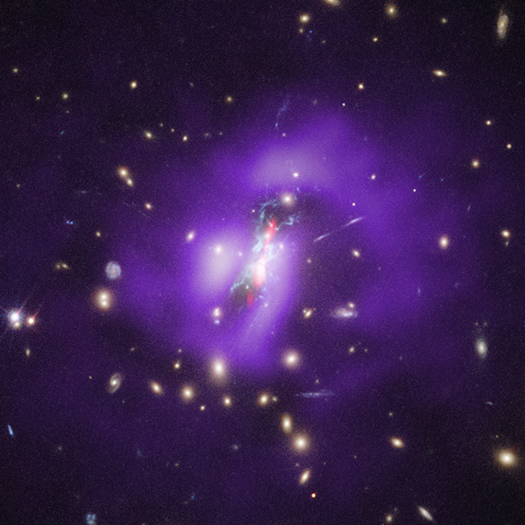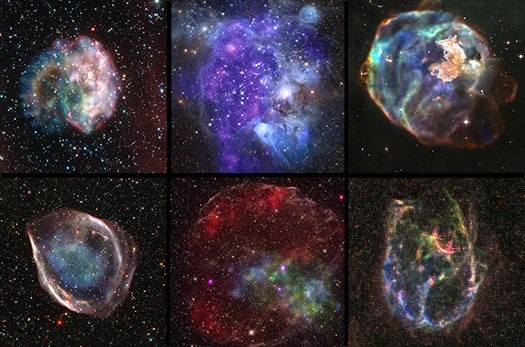Famous Black Hole Has Jet Pushing Cosmic Speed Limit
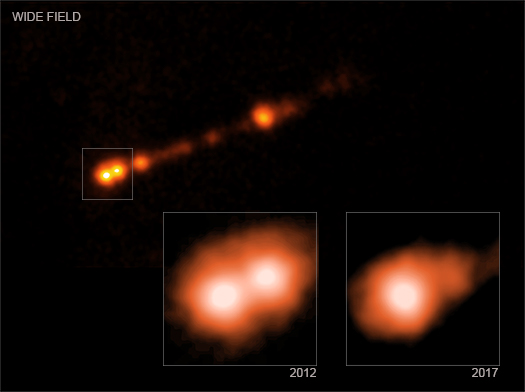
Supermassive Black Hole Jet in M87
Credit: NASA/CXC/SAO/B.Snios et al.
These images show evidence from NASA's Chandra X-ray Observatory that the black hole in the galaxy Messier 87 (M87) is blasting particles out at over 99% the speed of light, as described in our latest press release. While astronomers have observed features in the M87 jet blasting away from its black hole this quickly at radio and optical wavelengths for many years, this provides the strongest evidence yet that actual particles are travelling this fast. Astronomers required the sharp X-ray vision from Chandra in order to make these precise measurements.
The main panel of the graphic shows the entire length of M87's jet seen by Chandra, stretching for about 18,000 light years. "Knots" of X-ray emission seen here are created when material falls onto the M87 sporadically, creating bursts of X-ray light that travel along the jet and away from the black hole. The insets show Chandra observations taken in 2012 and 2017 of a small region near the base of the jet. The source in the lower left is X-ray emission from material around the black hole, and the other source is a knot in the jet about 900 light years from the black hole. This knot moves away from the black hole between 2012 and 2017 and also fades by 70%.
NASA's Great Observatories Help Astronomers Build a 3D Visualization of Exploded Star
In the year 1054 AD, Chinese sky watchers witnessed the sudden appearance of a "new star" in the heavens, which they recorded as six times brighter than Venus, making it the brightest observed stellar event in recorded history. This "guest star," as they described it, was so bright that people saw it in the sky during the day for almost a month. Native Americans also recorded its mysterious appearance in petroglyphs.
Observing the nebula with the largest telescope of the time, Lord Rosse in 1844 named the object the "Crab" because of its tentacle-like structure. But it wasn't until the 1900s that astronomers realized the nebula was the surviving relic of the 1054 supernova, the explosion of a massive star.
Now, astronomers and visualization specialists from the NASA's Universe of Learning program have combined the visible, infrared, and X-ray vision of NASA's Great Observatories to create a three-dimensional representation of the dynamic Crab Nebula. Certain structures and processes, driven by the pulsar engine at the heart of the nebula, are best seen at particular wavelengths.
Galaxy Gathering Brings Warmth

NGC 6338
Credit: X-ray: Chandra: NASA/CXC/SAO/E. O'Sullivan; XMM: ESA/XMM/E. O'Sullivan; Optical: SDSS
As the holiday season approaches, people in the northern hemisphere will gather indoors to stay warm. In keeping with the season, astronomers have studied two groups of galaxies that are rushing together and producing their own warmth.
The majority of galaxies do not exist in isolation. Rather, they are bound to other galaxies through gravity either in relatively small numbers known as "galaxy groups," or much larger concentrations called "galaxy clusters" consisting of hundreds or thousands of galaxies. Sometimes, these collections of galaxies are drawn toward one another by gravity and eventually merge.
Using NASA's Chandra X-ray Observatory, ESA's XMM-Newton, the Giant Metrewave Radio Telescope (GMRT), and optical observations with the Apache Point Observatory in New Mexico, a team of astronomers has found that two galaxy groups are smashing into each other at a remarkable speed of about 4 million miles per hour. This could be the most violent collision yet seen between two galaxy groups.
A Friendly Neighborhood Supermassive Black Hole

Roberto Gilli
We are very happy to welcome Roberto Gilli as our guest blogger. Dr. Gilli is the first author of a paper that is the subject of our latest Chandra press release. He received his Ph.D. in astronomy from Firenze University in Italy in 2001. Afterward, he did a post-doctoral fellowship at The Johns Hopkins Observatory before returning to Firenze at the Arcetri Astrophysical Observatory. Today, he is an astronomer at the National Institute of Astrophysics (INAF) in Bologna, Italy, a position he has held since 2005. His research interests include active galactic nuclei, quasars, and deep X-ray surveys.
Black holes are usually perceived as dangerous, disruptive systems. On the one hand they swallow copious amount of matter. On the other, they release a large amount of energy in the form of both radiation and matter when enormous quantities of material fall onto them.
The most extreme manifestation of such phenomenon is known as a "quasar" or an "active galactic nucleus" (AGN) that are powered by growing supermassive black holes (SMBHs) at galaxy centers. During these growth phases, part of the gravitational energy of the infalling gas is converted into strong electromagnetic radiation. Meanwhile, some of the gas, rather than being swallowed by the black hole, is instead accelerated and pushed very far away in the form of fast winds or even faster jets that can approach the speed of light.
A Weakened Black Hole Allows Its Galaxy to Awaken
The Phoenix galaxy cluster contains the first confirmed supermassive black hole that is unable to prevent large numbers of stars from forming in the core of the galaxy cluster where it resides. This result, reported in our latest press release, was made by combining data from NASA's Chandra X-ray Observatory and Hubble Space Telescope, and the NSF's Karl Jansky Very Large Array (VLA). A new composite image shows data from each telescope. X-rays from Chandra depict hot gas in purple and radio emission from the VLA features jets in red. Optical light data from Hubble show galaxies (in yellow), and filaments of cooler gas where stars are forming (in light blue).
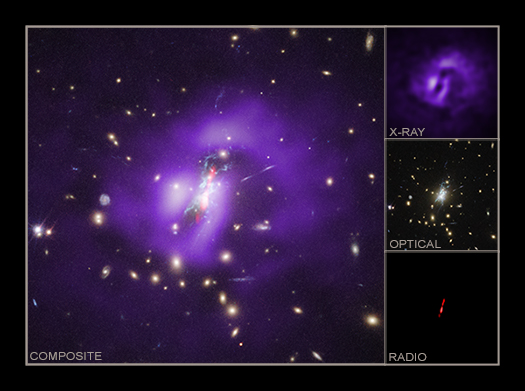
Behind the Scenes with the Image Makers
Credit: Enhanced Image by Judy Schmidt (CC BY-NC-SA) based on
images provided courtesy of NASA/CXC/SAO & NASA/STScI.
It is both an art and a science to make images of objects from space. Most astronomical images are composed of light that humans cannot detect with their eyes. Instead, the data from telescopes like NASA’s Chandra X-ray Observatory are “translated,” so to speak, into a form that we can understand. This process is done following strict guidelines to ensure scientific accuracy while trying to achieve the highest levels of aesthetics possible.
Over the two decades of the Chandra mission, we have had many talented people who have been involved with making our publicly-released images. We interviewed our current team and share some of their answers to questions posed to all of them below. Kim Arcand is Chandra’s visualization lead and has been with the mission since before launch; Nancy Wolk has been involved with Chandra’s data analysis, software, and spacecraft science operations before joining the image processing team; Lisa Frattare spent years making images from the Hubble Space Telescope before switching career gears but continues to lend her expertise part-time to Chandra’s efforts; Judy Schmidt is a citizen scientist who spends some of her free time using public data to make gorgeous images of space, including those featured in our latest release.
Witnessing the Formation of One of the Most Massive Objects in the Universe

Gerrit Schellenberger
We welcome Gerrit Schellenberger as our guest blogger. He received his PhD in Bonn, Germany in 2016, and has been a post-doctoral researcher at the Center for Astrophysics | Harvard & Smithsonian since March 2016. His research includes working on galaxy clusters and groups in large samples for cosmology, but also on individual objects in the X-rays and in the radio regime.
From the beginning of my astronomical career, I was fascinated by studying galaxy clusters, consisting of hundreds, sometimes even thousands of galaxies held together by gravity only. Yet, the galaxies alone do not — by far — sum up to the mass necessary to keep the cluster bound together. Beginning in the 1970s after the birth of X-ray astronomy and the first imaging satellites such as Einstein and ROSAT, scientists discovered that a very hot gas exists between the galaxies of the cluster. The mass of this gas exceeds the mass of all the stars in the galaxies together.
Although this gas is the most dominant, visible structure in galaxy clusters, it is only about 10% of the total mass (while the stars in the galaxies make only about 1%). The rest, roughly 90%, is dark matter, which cannot be observed directly. However, we can see its effect on the hot gas and galaxies in galaxy clusters: the gravity not only keeps the galaxies within the cluster, but also compresses the gas, heating it to the point where it emits X-rays. So we can study dark matter in clusters by measuring the properties (like temperature) of the hot gas from the X-ray emission.
Intrigued by this, I started to analyze a sample comprising 64 clusters during my PhD in Bonn, Germany, with the goal of obtaining total masses (including the dark matter component) for all of them. It turns out that smaller and lighter galaxy clusters, also called galaxy groups, do not follow the expected scaling between X-ray emission and temperature at a given cluster mass, meaning that the X-ray properties of gas in these systems cannot be used to give reliable mass estimates. Therefore, galaxy groups can only be of limited use for cosmological studies, where it is crucial to estimate the amount of matter in objects and how it changes with cosmic time.
Tycho's Supernova Remnant: The Clumpy and Lumpy Death of a Star
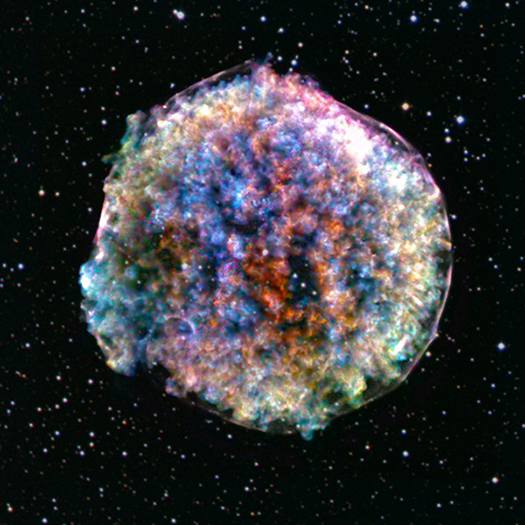
Tycho's Supernova Remnant
Credit: X-ray: NASA/CXC/SAO.; Optical: DSS
In 1572, Danish astronomer Tycho Brahe was among those who noticed a new bright object in the constellation Cassiopeia. Adding fuel to the intellectual fire that Copernicus started, Tycho showed this "new star" was far beyond the Moon, and that it was possible for the Universe beyond the Sun and planets to change.
Astronomers now know that Tycho's new star was not new at all. Rather it signaled the death of a star in a supernova, an explosion so bright that it can outshine the light from an entire galaxy. This particular supernova was a Type Ia, which occurs when a white dwarf star pulls material from, or merges with, a nearby companion star until a violent explosion is triggered. The white dwarf star is obliterated, sending its debris hurtling into space.
Hunting Elusive Giants: Chandra Spots a Triple AGN

Ryan W. Pfeifle
We welcome Ryan W. Pfeifle as our guest blogger. He received his B.S. in Physics from George Mason University (GMU) in 2017, and then stayed at GMU to continue onto his Ph.D and work with his current advisor on colliding galaxies and active galactic nuclei (AGNs). He is currently a third-year graduate research assistant in the Department of Physics and Astronomy at GMU. His primary focus is the identification and characterization of dual and triple AGNs in advanced mergers in an effort to understand the relationship between galaxy mergers and black hole growth. He has two recently published papers, one on their dual AGN program (published in April and available here), and one that is the focus of this press release, published in the Astrophysical Journal and available here. In addition to his research work, he is a tour guide at the GMU observatory in Fairfax, VA.
Over the past several decades, we have come to understand that supermassive black holes (SMBHs), with masses in the range of one million to several billion times the mass of our own sun, reside at the centers of most massive galaxies. Not only do we see these SMBHs in nearby galaxies, we also see them in galaxies as early as a few hundred million years after the Big Bang! Astronomers are still struggling to explain how these massive black holes could grow to these immense sizes so quickly, but one possible explanation lies in the interactions between galaxies.
Found: Three Black Holes On Collision Course
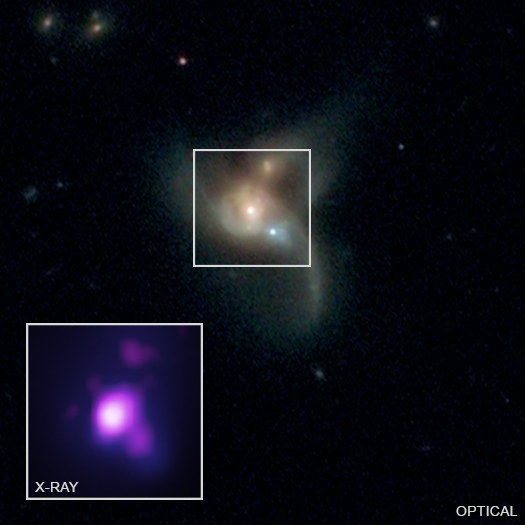
SDSS J084905.51+111447.2
Credit: X-ray: NASA/CXC/George Mason Univ./R. Pfeifle et al.; Optical: SDSS & NASA/STScI
A new study using data from NASA's Chandra X-ray Observatory and other telescopes provides the strongest evidence yet for a system of three supermassive black holes, as described in our latest press release. Astronomers think these triplet collisions, while extremely rare, play a critical role in how the biggest black holes grow over time.
The system is known as SDSS J084905.51+111447.2 (SDSS J0849+1114 for short) and is located a billion light years from Earth. In this graphic, X-rays from Chandra (purple) are shown in the pull-out in comparison with optical light from the Hubble Space Telescope and the Sloan Digital Sky Survey (red, green, and blue) in the main panel.

